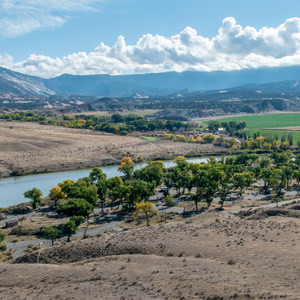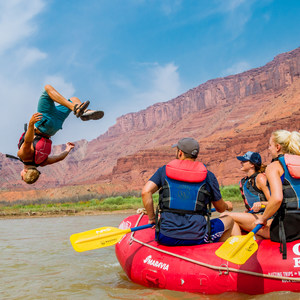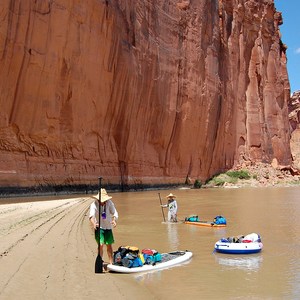You are here
Over 21,900 cubic feet per second. More than 15 major dams and hundreds of smaller tributary damming projects. 1,470 miles long. The Colorado River starts at 10,000 feet elevation in the Rocky Mountains of Colorado and winds its way through seven states and two countries. Roughly 242,000 square miles of land spread across the Colorado River Basin, which is a vast amount of land to comprehend. The river's watershed is so large that it can be hard to put a finger on a map and say “Here. Here is the place that defines the Colorado.”
The Colorado River, and the tributaries that feed it, drain western Colorado, southwestern Wyoming, sections of Utah, Nevada, New Mexico, California, and Arizona. Federal lands such national forests and parks constitute the majority of the area. Because of the original allocation of water rights between Upper Basin and Lower Basin users was completed in 1922, which was a year of plentiful water, the water has been overallocated in nearly all sections of the river. Planners had no idea of just how much development would eventually reach this region. Today, it is a rare event for water to actually reach the Gulf of California in Mexico.
How is all this water used? Roughly 80% goes toward the biggest consumer, agriculture, according to The Nature Conservancy. Pasture and cropland in the Colorado River basin all require irrigation. Forage crops for feeding cattle and horses use up the most of the water here. Techniques to improve the efficiency of water use have been improving, and farmers have made significant progress in reducing their water consumption. The challenge comes from rapidly increasing population and development; rising demands for clean drinking water are competing with agriculture. Cities will also need to find ways to improve and reduce the amount of water they pull from the system.
Recreation in the basin has been both a positive and negative development. According to the Environmental Defense Fund and a report published by Colorado College, “Active outdoor recreation in the Colorado River Basin contributes more than $75 billion annually to the region’s economy and supports more than 780,000 jobs.” Impressive numbers indeed! The economic benefits are large, but all of these same recreationalists create added demand on the water system in their own consumption.

Development and damming has created enormous lakes for fishing, boating, and swimming. These same lakes were formed in the development of dozens of other dams, small and large, to harness hydroelectric power and supply electricity to millions. Projects like the Glen Canyon Dam and Hoover Dam are the most readily familiar dams to most people. Unfortunately, as water levels decrease, the amount of electricity produced by these dams has declined. Severe drought related to climate change, along with high demand for withdrawals of water from the river for municipal and agricultural use, mean that reservoirs behind these major dams do not see the same high water levels that they did in the past. Lower water levels mean less power production.
All of this competition for a dwindling resource has meant a high level of litigation between states, and even between the U.S. and Mexico, the final user in the long run of the Colorado River. Legislation technically covers how water is allocated between Upper Basin states, Lower Basin states, Native American tribes, and federal public lands, but that doesn’t mean that everyone agrees with the interpretation of said law.
These conflicts are only expected to increase as climate change and the potential for more weather extremes significantly affect the amount of water in the Colorado River Basin. Population and development increases will further exacerbate the problem. In the next piece in this series, we’ll look at specific points of conflict relating to the river and also look at conservation efforts being made to protect and enhance resources that make this ecosystem so unique.
For more information about the Colorado River watershed, follow the rest of the series here:








Comments
Sign In and share them.